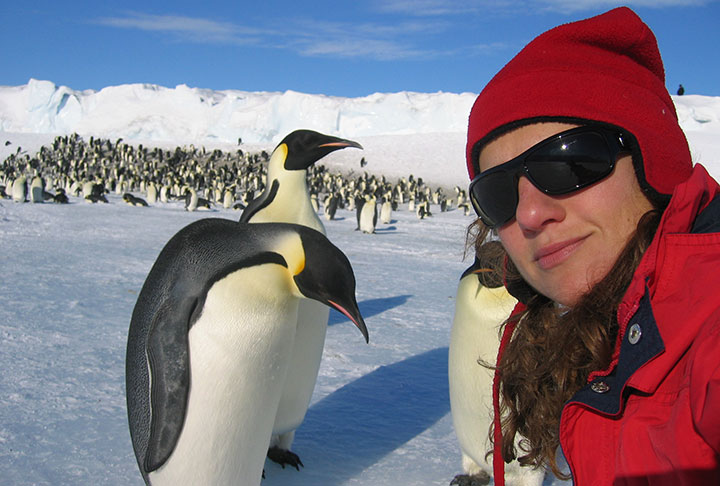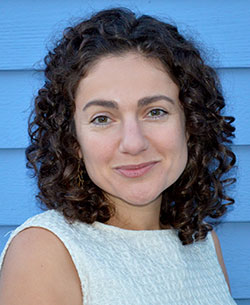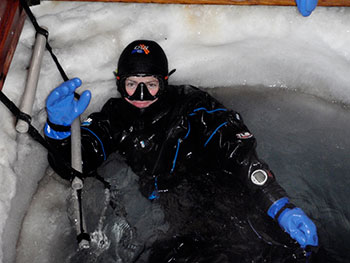Scripps Alumna Selected as a NASA Astronaut Candidate
Scripps graduate credits training, mentors at Scripps in preparing to be part of NASA’s newest space explorers
By:
- Mario Aguilera
Published Date
By:
- Mario Aguilera
Share This:
Article Content

Jessica Meir studied emperor penguins in Antarctica during her Scripps research
Jessica Meir, who earned a doctorate in marine physiology from Scripps Institution of Oceanography at UC San Diego in 2009, has been selected in the newest group of space explorers by NASA.
Meir is one of eight NASA astronaut candidates “who will help the agency push the boundaries of exploration and travel to new destinations in the solar system, including an asteroid and Mars,” NASA noted in a news release announcing the 2013 astronaut candidates.
While at Scripps, Meir worked with research physiologist Paul Ponganis of Scripps’s Center for Marine Biotechnology and Biomedicine to study how animals such as emperor penguins and elephant seals are capable of conducting remarkably long dives (Read about Meir’s research during her time at Scripps in explorations now magazine: http://explorations.ucsd.edu/research-highlights/2008/the-beat-goes-on-barely/).
“I’m incredibly excited about this opportunity to be a part of NASA’s human spaceflight program,” said Meir. “I’ve been very passionate about scientific outreach and education through my past research, and am thrilled to have another avenue to help inspire the next generation of scientists and explorers.”

Jessica Meir
Meir joins Scripps alumna Megan McArthur, a NASA astronaut who journeyed aboard the Space Shuttle Atlantis in 2009, in selection to NASA’s highly competitive astronaut training program.
“It’s incredibly encouraging to witness yet another UC San Diego graduate reach a position of such prominence and importance for America’s space explorations initiatives,” said UC San Diego Chancellor Pradeep K. Khosla. “Like Megan McArthur before her, Jessica Meir serves as an inspiration to all current and future Tritons that national and international leadership roles are well within your grasp with UC San Diego education and training.”
“We are looking forward to Jessica becoming a part of the astronaut corps,” said McArthur. “Her education and experiences at Scripps Institution of Oceanography, along with her many other accomplishments, have prepared her well for the challenging adventure she will be undertaking here at NASA.”
Meir said becoming an astronaut has been a dream since she was about five years old.
“It still feels incredibly surreal that my dream has actually come true,” she said.
Meir credits her time at Scripps as well as her mentors in aiding her astronaut candidacy.
“In her Ph.D. research, Jessica investigated the physiological and biochemical adaptations underlying the diving physiology and hypoxic (low oxygen) tolerance of deep diving emperor penguins and elephant seals,” said Ponganis. “Such research is relevant both to understanding the dive behavior and ecology of these species and to biomedical applications such as minimization of tissue damage during heart attacks and strokes. The principles of diving physiology are also relevant to avoidance of decompression sickness, a potential problem for astronauts during extra vehicular activity in space.”

Jessica Meir ice diving in Antarctica
“My Ph.D. training at Scripps certainly helped me prepare for this new adventure, from the experience I gained in critical thinking, to the operational skills I acquired on the sea ice of the Antarctic and the beaches of California during my field work,” said Meir. “I have been incredibly fortunate to have benefited from an amazing run of mentors throughout my career, including Scripps’s Paul Ponganis and Jerry Kooyman, individuals who are not only amazing scientists, but amazing people as well. The influence that these individuals have made on my life both professionally and personally is invaluable.”
A native of Caribou, Maine, Meir earned a bachelor’s degree in 1999 from Brown University, attended the International Space University in France, and supported human physiology experiments at NASA’s Johnson Space Center in Houston. After obtaining her Ph.D. at Scripps Oceanography, Meir investigated hypoxia tolerance in the high-flying bar-headed goose as a post-doctoral researcher at the University of British Columbia in Vancouver.
She is currently an assistant professor of anesthesia at Harvard Medical School, Massachusetts General Hospital, in Boston.
Meir was selected from the second-largest number of applications—more than 6,000—in NASA’s history. The 2013 selections are NASA’s 21st class since the first group was chosen in 1959.
“These new space explorers (were) asked to join NASA because they know we’re doing big, bold things here—developing missions to go farther into space than ever before,” said NASA Administrator Charles Bolden in a NASA news release. “They’re excited about the science we’re doing on the International Space Station and our plan to launch from U.S. soil to there on spacecraft built by American companies. And they’re ready to help lead the first human mission to an asteroid and then on to Mars.”
Share This:
You May Also Like
Stay in the Know
Keep up with all the latest from UC San Diego. Subscribe to the newsletter today.



